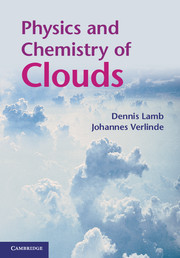Book contents
- Frontmatter
- Contents
- Preface
- Part I Background
- Part II Transformations
- Part III Cloud macrophysics
- 5 Cloud thermodynamics
- 6 Cloud formation and evolution
- Part IV Cloud microphysics
- Part V Cloud-scale and population effects
- Appendix A Cloud classification
- Appendix B Overview of thermodynamics
- Appendix C Boltzmann distribution
- References
- Index
6 - Cloud formation and evolution
from Part III - Cloud macrophysics
Published online by Cambridge University Press: 07 October 2011
- Frontmatter
- Contents
- Preface
- Part I Background
- Part II Transformations
- Part III Cloud macrophysics
- 5 Cloud thermodynamics
- 6 Cloud formation and evolution
- Part IV Cloud microphysics
- Part V Cloud-scale and population effects
- Appendix A Cloud classification
- Appendix B Overview of thermodynamics
- Appendix C Boltzmann distribution
- References
- Index
Summary
Clouds form when atmospheric conditions become appropriate. The necessary ingredients for cloud formation include an adequate supply of water vapor, aerosol particles, and a mechanism for cooling the air. Water, in condensed form, is, of course, the primary component of any cloud. The aerosol particles provide the sites for condensation by offering places where water vapor can adhere. Cooling lets condensation take place by causing the physical temperature to fall below the dew point and the concentration of water vapor to exceed the equilibrium value.
The properties of the resulting cloud depend on both macro- and micro scale processes. The macroscale air motions, driven by atmospheric pressure gradients, move the requisite water vapor and aerosol particles upward toward lower pressures, thereby cooling the air and generating excess water vapor. The microphysical processes, driven initially by aerosol abundance, determine how the excess vapor is utilized within the cloud. This chapter offers an overview of the macroscale processes that produce environments conducive to cloud formation. Subsequent chapters focus on the evolution of the microphysical properties.
Cooling mechanisms
A cloud, the visible aggregation of liquid or ice particles suspended in the atmosphere, requires cooling so that the partial pressure of vapor, pH2O ≡e, can exceed the equilibrium vapor pressure of the condensate, eeq(T), a function that increases monotonically with temperature T.
Information
- Type
- Chapter
- Information
- Physics and Chemistry of Clouds , pp. 242 - 274Publisher: Cambridge University PressPrint publication year: 2011
